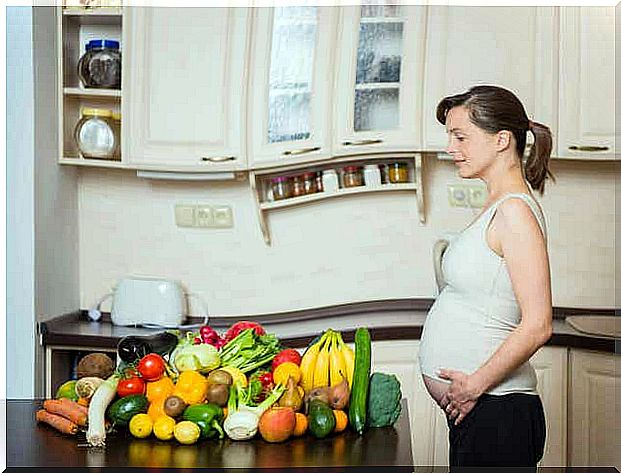Eat Green Leafy Vegetables During Pregnancy

Did you know that a woman’s nutritional needs increase during pregnancy? That’s why doctors prescribe supplements like folic acid when they can’t be covered by food. It is a vitamin involved in the development of the future baby, so it is essential to include them in your diet daily during the nine months of pregnancy. That is why we want to explain why it is important to eat green leafy vegetables during pregnancy.
Folic acid belongs to the family of B vitamins and is soluble in water. Among other things, it is responsible for the formation of the corpus luteum, characterized by its yellow color, which allows the fetus to develop. It is also involved in DNA synthesis and cell division, so it is essential to meet daily needs.
Fetal malformations and why green leafy vegetables are important
The formation and closure of the neural tube produced during fetal growth are essential to prevent neurological problems and spina bifida. Respectively, they are manifested by a lack of coordination and thinking, as well as by difficulty walking. As a result, there is an increased risk of miscarriage.

One of the causes is the lack of folic acid, which we can find in green leafy vegetables. Your doctor will probably also prescribe a supplement of 400 micrograms per day as a preventative measure.
Anemia due to folic acid deficiency
Although the most well-known form of anemia is caused by iron deficiency, vitamin B9 and B12 deficiency are the main cause of megaloblastic anemia. It is manifested by an increase in the size of red blood cells and a decrease in their intense red color.
As a result, it reduces the transport of oxygen and blood to the tissues. It is manifested by gastrointestinal symptoms such as diarrhea, swelling of the tongue due to inflammation and loss of appetite.
Furthermore, these vitamins prevent homocysteine from accumulating in the blood. Homocysteine is a protein derived from methionine metabolism and its excess has been linked to increased cardiovascular risk.
Other reasons to eat green leafy vegetables during pregnancy
While neural tube defects and anemia are the most well-known negative effects of vitamin B9 deficiency, there is evidence of other consequences.
A study conducted in China claims that taking supplements for 12 weeks reduces the risk of preterm birth.
As a result of the appearance of these pathologies, many countries have chosen to enrich food. However, some countries still do not and this is where the relationship with the occurrence of asthma in children has been noted.
For this reason, they decided to conduct their research in a country that does adopt this practice of food fortification, such as the United States. Although there was a lower incidence of asthma, it is important to point out that it is a respiratory disease linked to genetic and environmental factors, so may alter the results. Thus, more well-controlled studies are needed.
Finally, it has been linked to elevated blood pressure or preeclampsia. Normally it is multifactorial such as family history, being over 35 years old, obesity and multiple pregnancies.
However, increasing folic acid intake helps to reduce its occurrence, by taking 4 micrograms per day for three months.
How can you include green leafy vegetables in your diet on a daily basis?
Now that you know the above, why not try incorporating some more vegetables into your diet? Here are some ideas and tips you can use. Remember that this food group is the foundation of a healthy diet.

For example, have you ever thought of making a salad with leaves other than lettuce and endive? In the supermarket you will find a wide variety, such as lamb’s lettuce, arugula, spinach and endive. Add a can of fish in olive oil, tomatoes, carrots, celery or radishes. You can even add some slices of orange or mango. Or add sliced strawberries and some nuts or raisins for a unique nutrient-packed dish.
Or make steamed chard or broccoli and then sauté it with a little garlic and paprika or some chopped almonds with parsley and some grated lemon zest.
In addition, oat flakes also contain folic acid. You can eat them daily. They are also delicious in stews with chickpeas or lentils! Or you can make cooked oatmeal with milk or a plant-based milk with a cinnamon stick and some lemon zest. So what are you waiting for?









